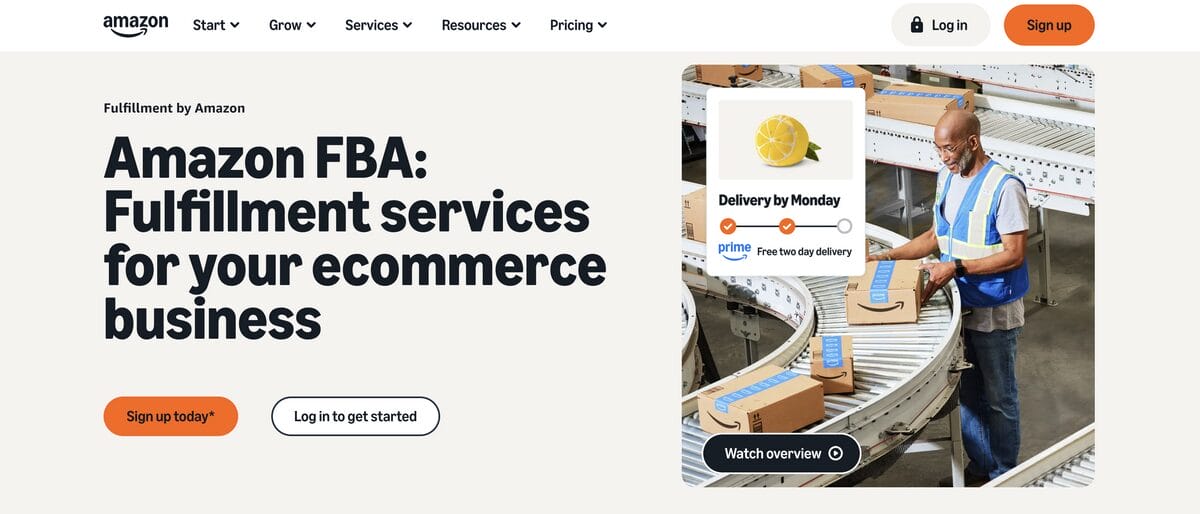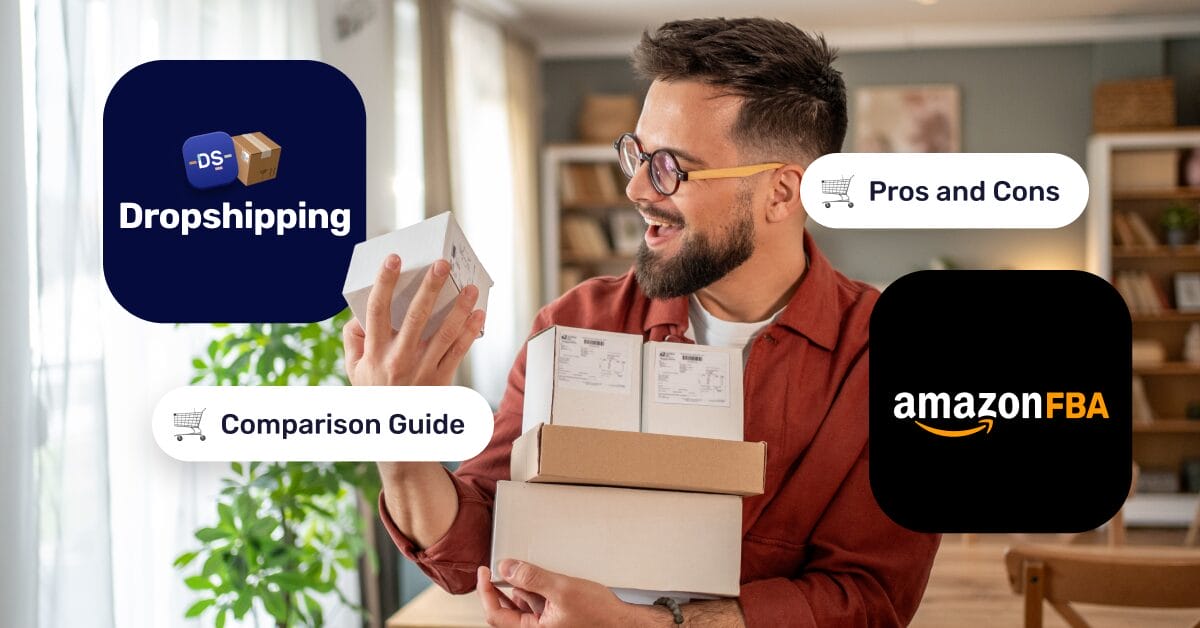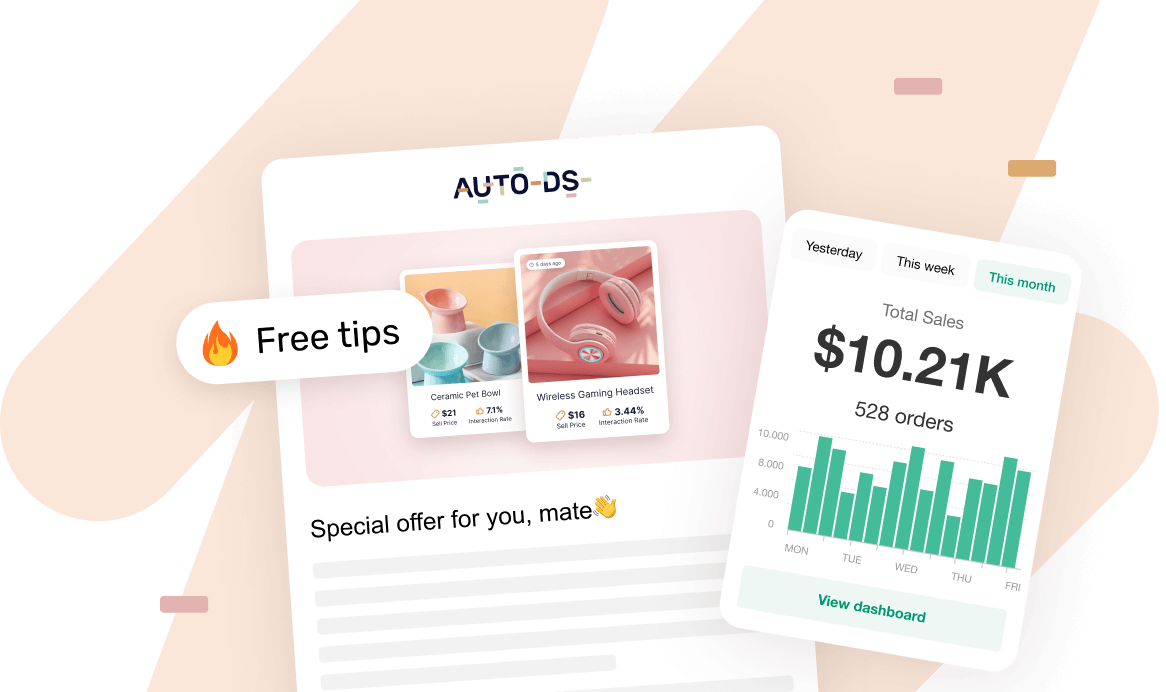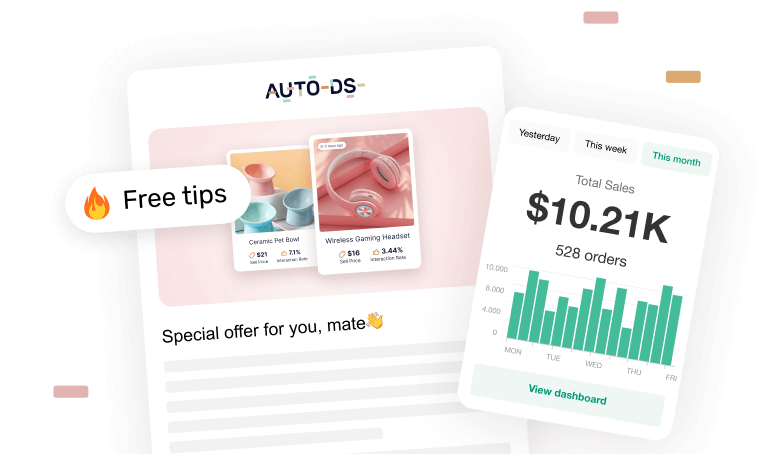Thinking about (or already are) dropshipping on Amazon? Then you’ve probably heard of Fulfillment by Amazon (FBA). This is Amazon’s own fulfillment service. A system where you use Amazon’s warehouses to store, pack, and ship the products you’re selling. It basically handles logistics while you manage listings.
Another alternative is dropshipping. This one is all about creating your own brand without making or holding the products you sell. But instead of working only with Amazon, you partner with third-party suppliers (one, two, or multiple) to source your products and ship them to your customers.
Both are great alternatives to sell without the hassle of logistics. Now the question is…which one is better? In this guide, we’ll cover everything you need to know about Amazon FBA vs dropshipping. We’ll explain how each model works, their pros and cons, and how to choose the right one for your business.
We’ll also share tools and tips to make the best of dropshipping. For instance, AutoDS automates your entire dropshipping workflow to simplify operations and fulfillment on Amazon.
Fulfillment by Amazon (FBA) offers faster shipping and higher trust through Amazon’s network, but requires upfront investment. This is perfect for Amazon-experienced sellers.
Dropshipping is lower-risk, more flexible, and perfect for testing products without big costs. It’s ideal for beginners or sellers looking for agile business models.
You can use both models for maximum results and scalability. Many sellers use dropshipping to test products, then move their best performers to FBA for long-term growth.
AutoDS simplifies both, connecting you with vetted suppliers who comply with Amazon, automating product imports, monitoring price and stock, and automating fulfillment if you’re using the dropshipping model.
What Is Fulfillment by Amazon (FBA)?

Fulfillment by Amazon (FBA) is basically hiring Amazon to do most of the work for you. You’re not storing, packing, and shipping products yourself. You just send your inventory to Amazon’s fulfillment centers, and they take care of the rest. You know, shipping orders, managing returns, and even answering customer questions.
For sellers, this setup is pretty convenient if you hate logistics. Your products also get the Prime badge, which means faster shipping and more visibility to millions of loyal Amazon buyers. The trade-off? You pay storage and fulfillment fees. Moreover, you give up a bit of control (since Amazon is now running most of your business).
But here’s the thing with FBA: unlike dropshipping, you actually have to buy inventory to send it to Amazon. This means a big upfront investment.
This makes it a better option for those who already have some capital, a proven product, or want to scale an existing manufacturing brand. It’s also a good idea for those who are already dropshipping on Amazon and want to take it to the next level. But it’s not the best option for beginners testing the waters or sellers who don’t want to buy inventory.
What Is Dropshipping?
Dropshipping is the opposite of buying and holding inventory. It’s all about selling first and buying later. No holding inventory, no upfront investments. You basically source products across marketplaces, list them on your site, and only buy them if someone actually places an order. This is how it works:
- You list your suppliers’ products on your store.
- Once an order is placed on your store, you buy the product from your supplier.
- Your supplier ships the order directly to your customer. You never even touch the product itself.
- Your customer receives the order, and you keep the profit margin, which is the difference between the price you charged them and the amount you paid your supplier. In other words? It’s the reward you get for connecting the dots between the product and the buyer.
In this chain, your job is not really handling logistics. Instead, your main responsibility is sourcing, finding the right suppliers, and doing marketing to increase your listings’ visibility. The better your strategy for these three pillars, the more successful your dropshipping business will be.
AutoDS makes it easy to start and scale your dropshipping business fast. Give it a try and start sourcing products, optimizing listings, and automating fulfillment in just a few clicks 👉 Start your $1 trial today!
Amazon FBA vs Dropshipping: Key Differences
At first glance, Fulfillment by Amazon and dropshipping might seem like two similar ways to reach the same goal: selling products online without holding inventory. But they’re actually pretty different. Here’s a detailed Amazon FBA vs dropshipping breakdown:
Inventory And Upfront Costs
Both models let you skip inventory management. But they do it in different ways. With FBA, you buy products in bulk and send them to Amazon’s warehouses before you sell them. This means you actually need to invest in stock.
Dropshipping, on the other hand, doesn’t require an upfront investment. It lets you sell first and buy later. In fact, you can totally start dropshipping with no money and only buy products or invest in your tech stack as you receive sales and start growing.
Fulfillment And Control
When it comes to fulfillment, both options are solid as well. With FBA, Amazon handles everything, from packing to shipping and customer support. This is convenient, but it gives you less control. You basically have no brand, no contact with your customers, and no presence.
Instead, dropshipping gives you more flexibility. Your supplier handles fulfillment and shipping, but you have more control over your brand. You manage your listings, set your prices, design your store, and decide how to market your products. All without being tied to Amazon’s strict system or fees.
All in all, as a dropshipper, you also get access to more product variety (as you can add items daily to your store), decide who fulfills it, how your store looks, what packaging looks like, and so on.
Risk And Scalability
FBA lets you scale fast, but at a great risk. Because you’re selling inside Amazon’s marketplace with the Prime badge, you get access to millions of buyers. This makes it easy to scale super quickly. However, you need capital to invest and continue reinvesting, and leftover stock can eat into your profits. This makes it scalable, but it also makes it high-risk.
Instead, dropshipping scales more gradually, but with less financial risk. If a listing doesn’t sell, you simply stop selling it. There’s no leftover inventory and no wasted money. This also makes it easy to constantly test and adapt until you find the products that stick.
You just have to pay close attention to the Amazon dropshipping suppliers you choose. Make sure they comply with shipping times and quality standards.
Amazon FBA vs Dropshipping: Comparison Table
| Aspect | Amazon FBA | Dropshipping |
|---|---|---|
| Inventory | Buy it upfront | Buy it after a customer places an order |
| Upfront costs | High | Low |
| Risk | High | Low |
| Fulfillment | Fulfilled by Amazon | Fulfilled by your supplier |
| Control | Limited (Amazon controls most of the process) | High (you’re in control of store, pricing, and suppliers) |
| Profit margins | Higher | Lower |
| Scalability | Faster | Gradual |
| Branding | Limited | Full branding freedom |
| Best For | Experienced sellers or brands with proven demand | Beginners or sellers testing niches and products with minimal risk |
Amazon FBA vs Dropshipping: Which Is Better for You?
So, the final showdown. Dropshipping vs Amazon FBA… which one wins? The short answer: it depends on where you are in your e-commerce journey. Here’s a quick quiz to see which one fits you better:
👉Just starting out? Then dropshipping is the clear winner. No inventory, minimal upfront costs, and quick setup. This means you can test different niches without risking your savings.
🆕 Beginner’s Tip: Need a little hand to get started? AutoDS helps beginners start dropshipping in minutes with automated tools, from product sourcing to fulfillment.
👉Already have experience selling online? Then you can give FBA a chance for your next step. It’s perfect for scaling your operations, improving delivery speed, and reaching Amazon’s Prime audience. Just remember: you’ll have to handle higher costs and stricter policies.
👉Want to mix things up a bit? Then you can try both. Many successful entrepreneurs do this for smarter strategies. You can test new products via dropshipping. Then, you can invest in your proven winners and move them to FBA for faster shipping and higher trust. It’s the best of both worlds: flexibility when you need it, and stability when you scale.
How AutoDS Supports Dropshippers (and FBA Sellers)

Whether you’re a team dropshipping, team FBA, or somewhere in between, AutoDS makes the entire process easier, faster, and more profitable. Here’s how:
- Automates product imports, pricing, and inventory from over +25 suppliers. This way, you never have to copy product details, monitor suppliers’ prices, update your listings, and so on. Everything works on autopilot.
💡 Pro tip: Amazon has strict rules when it comes to dropshipping. If you want to skip compliance headaches, Fulfilled by AutoDS not only automates fulfillment, but it also uses AutoDS’s own seller accounts to protect your seller metrics and make sure the order complies with every Amazon dropshipping policy.
- Integrates with major selling platforms, like Amazon, eBay, Shopify, Etsy, and more. This lets you manage everything from one single place, even if you have operations running on multiple selling channels.
- Helps you test products for FBA validation. You can do this without any risks through dropshipping. AutoDS provides product sourcing tools, plus an exclusive marketplace with real-time market insights. This way, you can test, validate, and then move to Amazon later.

- Simplifies analytics and fulfillment in one single place. You can see how your listings are performing, which orders are active, request a return, and more…all in just a few clicks and without juggling multiple tabs and tools.
Like YouTuber Journey With The Hintons explains: “With one click, they are able to import their products directly into their Amazon store. And when someone places an order, AutoDS will fulfill it for you, which means they will be the one who’s ordering it from the supplier, so you don’t have to do that. They will also send tracking numbers to the marketplace, which will then update the customer. And if you have any kind of refunds, they take care of that too”.
All in all, AutoDS acts like your headquarters for all things dropshipping, letting you manage, automate, and sync every aspect of your business. If you want to give it a try, start the 14-day trial today for just $1!
Frequently Asked Questions
Can I use AutoDS for Amazon FBA?
Yes, you can use AutoDS to automate some parts of your Amazon FBA business, like product sourcing and testing.
Which model is more profitable, Amazon FBA or dropshipping?
Profitability depends on your strategy. FBA usually offers higher margins per product, but requires upfront investment and storage fees. Dropshipping has smaller margins but lower risk and faster testing. This is perfect for discovering what sells before scaling up.
Can I switch from dropshipping to FBA later?
Yes, you can switch from dropshipping to FBA later. These models are not opposite to each other. Many sellers start with dropshipping to find winning products, then move those best-sellers to FBA for faster shipping and Prime visibility. It’s a smart, low-risk way to grow.
Is dropshipping allowed on Amazon?
Yes, dropshipping is allowed on Amazon, but with limitations. You must follow Amazon’s dropshipping policy. That means being the seller of record, not using other retailers to fulfill orders, and making sure your packaging and invoices show your brand, not your supplier’s. AutoDS helps you stay compliant with vetted suppliers, stock and price monitoring, and automated fulfillment.
How does AutoDS make dropshipping easier?
AutoDS makes dropshipping easier by automating every step of the workflow, from product sourcing and importing to order fulfillment, automating tracking updates, and price and stock monitoring. This saves hours of manual work, reduces errors, and lets you focus on marketing and growth instead of micromanaging every order.
Start Your Dropshipping Journey with AutoDS
Both Amazon FBA and dropshipping can lead to a successful e-commerce business. They just take different roads to get there. FBA gives you Amazon’s power and Prime badge, but it requires upfront investment. On the other hand, dropshipping offers more flexibility, less risk, and faster testing. This is ideal for beginners or anyone who prefers a straightforward approach to selling online.
No matter which path you take, AutoDS makes it easier with automated product imports, fulfillment, price syncing, and stock monitoring. It handles the heavy lifting so you’re not stuck manually doing every little task.
And if you’re eager to know more about dropshipping on Amazon, here are a few more reads you might find helpful in crafting your strategy:
















